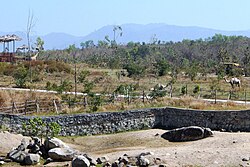로도스피릴룸 루브럼
Rhodospirillum rubrum| 로도스피릴룸 루브럼 | |
|---|---|
 | |
| 과학적 분류 | |
| 킹덤: | |
| 망울: | |
| 클래스: | |
| 순서: | |
| 패밀리: | |
| 속: | |
| 종: | R. 루브럼 |
| 이항식 이름 | |
| 로도스피릴룸 루브럼 (1887년 3월) 몰리슈 1907년[1] | |
Rhodospirillum rubrum(R. rubrum)은 그램 음성의 분홍색 계열의 프로테오박테리움으로, 크기는 800~1000나노미터에 이른다.이것은 기능성 혐기성 항산화제여서 유산소 조건에서 유산소 호흡에 산소를 사용할 수 있고 혐기성 조건 하에서 혐기성 호흡에 대체 단자 전자 수용체 역할을 한다.R. 루브럼용 대체 단자 전자 수용체에는 황산화 디메틸 또는 산화트리메틸이 포함된다.[2]
에어로빅 성장 하에서 광합성은 유전적으로 억제되고 R. 루브럼은 무색이다.산소가 소진된 후 R. 루브럼은 즉시 막 단백질, 박테리오클로로필, 카로티노이드 등을 포함한 광합성 기구의 생성을 시작한다. 즉, 박테리아가 광합성 활동을 하게 된다.광합성을 위한 억제 메커니즘은 잘 이해되지 않는다.R. 루브럼의 광합성은 엽록소 a가 아니라 박테리오염소엽록소를 가지고 있기 때문에 식물의 광합성과는 다르다.박테리오클로로필은 800~925nm의 최대 파장까지 빛을 흡수할 수 있는 반면, 엽록소는 660~680nm의 최대 파장을 가진 빛을 흡수한다.R. 루브럼은 나선형 박테리아(정신, 복수형: 나선형)이다.
R. 루브럼은 또한 질소 고정 박테리아로서, 즉 대기 중 이질소성분의 암모니아로의 전환을 촉진시킬 수 있는 단백질 복합체인 질소효소를 표현하고 조절할 수 있다.이 박테리아가 암모니아, 어둠, 페나진 메타황산염에 노출되면 질소 고정은 멈춘다.[3]이 중요한 특성 때문에, R. 루브럼은 이 반응이 일어나는데 필요한 복잡한 규제 체계를 이해하기 위해 많은 다른 그룹의 시험 대상이었다.[4][5][6][7]R. 루브럼에서 처음으로 질소산화물의 변환 후 규제가 입증되었다.질소효소는 글루타민 또는 암모니아와 어둠이라는 이른바 "스위치 오프" 이펙터에 반응하여 아르기닌 잔류물 101(Arg101)[8]의 ADP-리보실레이션에 의해 수정된다.[9]
R. 루브럼은 생명공학에서 몇 가지 잠재적인 용도를 가지고 있다.
- 생물 플라스틱 생산을 위한 세포 내 PHB(폴리-하이드록시-부트릭-아시드) 전구체의 정량적 축적.
- 생물학적 수소 연료의 생산.
- 경량 에너지에서 화학 에너지로의 전환과 질소 고정 시스템의 규제 경로를 연구하기 위한 모델 시스템.
참조
- ^ Parte, A.C. "Rhodospirillum". LPSN.
- ^ Schultz JE, Weaver PF (January 1982). "Fermentation and Anaerobic Respiration by Rhodospirillum rubrum and Rhodopseudomonas capsulata". Journal of Bacteriology. 149 (1): 181–190. doi:10.1128/JB.149.1.181-190.1982. PMC 216608. PMID 6798016.
- ^ Kanemoto RH, Ludden PW (May 1984). "Effect of ammonia, darkness, and phenazine methosulfate on whole-cell nitrogenase activity and Fe protein modification in Rhodospirillum rubrum". Journal of Bacteriology. 158 (2): 713–20. doi:10.1128/JB.158.2.713-720.1984. PMC 215488. PMID 6427184.
- ^ Teixeira PF, Jonsson A, Frank M, Wang H, Nordlund S (August 2008). "Interaction of the signal transduction protein GlnJ with the cellular targets AmtB1, GlnE and GlnD in Rhodospirillum rubrum: dependence on manganese, 2-oxoglutarate and the ADP/ATP ratio". Microbiology. 154 (Pt 8): 2336–47. doi:10.1099/mic.0.2008/017533-0. PMID 18667566.
- ^ Selao TT, Nordlund S, Norén A (August 2008). "Comparative proteomic studies in Rhodospirillum rubrum grown under different nitrogen conditions". Journal of Proteome Research. 7 (8): 3267–75. doi:10.1021/pr700771u. PMID 18570453.
- ^ Wolfe DM, Zhang Y, Roberts GP (October 2007). "Specificity and regulation of interaction between the PII and AmtB1 proteins in Rhodospirillum rubrum". Journal of Bacteriology. 189 (19): 6861–9. doi:10.1128/JB.00759-07. PMC 2045211. PMID 17644595.
- ^ Jonsson A, Teixeira PF, Nordlund S (May 2007). "The activity of adenylyltransferase in Rhodospirillum rubrum is only affected by alpha-ketoglutarate and unmodified PII proteins, but not by glutamine, in vitro". The FEBS Journal. 274 (10): 2449–60. doi:10.1111/j.1742-4658.2007.05778.x. PMID 17419734. S2CID 7043770.
- ^ Pope MR, Murrell SA, Ludden PW (May 1985). "Covalent modification of the iron protein of nitrogenase from Rhodospirillum rubrum by adenosine diphosphoribosylation of a specific arginine residue". Proceedings of the National Academy of Sciences of the United States of America. 82 (10): 3173–7. Bibcode:1985PNAS...82.3173P. doi:10.1073/pnas.82.10.3173. JSTOR 25545. PMC 397737. PMID 3923473.
- ^ Neilson AH, Nordlund S (November 1975). "Regulation of nitrogenase synthesis in intact cells of Rhodospirillum rubrum: inactivation of nitrogen fixation by ammonia, L-glutamine and L-asparagine". Journal of General Microbiology. 91 (1): 53–62. doi:10.1099/00221287-91-1-53. PMID 811763.


